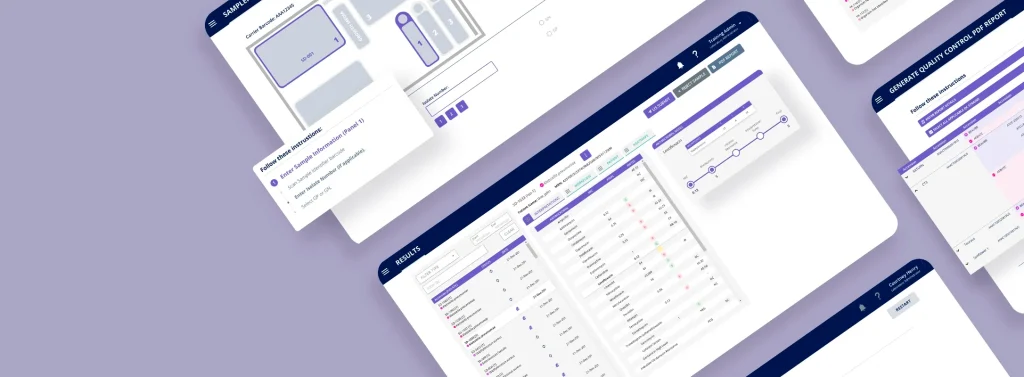We use cookies to ensure we give you the best experience on our website. By clicking Agree you accept our Privacy and Cookies Policy.
ML-powered laboratory diagnostics software

Industry
Biotech
Location
USA
Platform
Web
Cooperation
2+ years
About the project
Selux Diagnostics is a US-based biotech company that is revolutionizing precision diagnostics for infectious diseases. Their mission is to confront the global threat of antimicrobial resistance through rapid antibiotic susceptibility testing (AST) that will deliver fast, personalized therapies for patients in need.
Challenge
Antibiotic resistance is a global health crisis that is predicted to surpass deaths from cancer by 2050. Selux is addressing this problem and combating superbugs with their Next Generation Phenotyping (NGP) System, a rapid Antibiotic Susceptibility Testing (AST) system, that will transform patient care and personalized antibiotic therapies.
Developing this system required heavy engineering work on custom laboratory robotic instruments as well as extensive effort developing the Site Software platform which ties together these instruments, the user, and the laboratory’s existing equipment and databases. With the instrument development underway, the only missing component for Selux was a software partner to augment their existing Site Software team to expand the capabilities within tight timelines.
The Site Software platform needed to include a broad range of functions to be successful including:
- Interface to the laboratory’s Lab Information Systems (LIS) database for receiving orders and transmitting results
- Provide guided user instructions on preparing patient samples for testing and flow of information between each Selux instruments while testing is underway.
- Incorporate machine learning algorithms that analyze raw measurements from the instruments and convert that to clinically relevant results.
- Provide an easy way for users to review complex result reports to identify bacterial responses to antibiotics that may present patient treatment challenges or public health concerns.
- Provide all associated administrative tools for users and IT professionals to manage these various functions.

Solution
Blackthorn Vision helped Selux to add new functionality to the Site Software platform across a wide range of technologies necessary to assist lab technicians throughout antibiotic susceptibility testing and ensure error-free results.
Our dedicated developers, under the guidance of Selux’s Director of Software and Head of Algorithm and Data Science, made contributions, implementing major functional areas of this software platform. From developing machine learning infrastructure to database interfaces, to UI design and implementation, our team worked seamlessly alongside Selux’s internal team to deliver a solution that met all the challenges and volatile nature of bacterial infection treatment.
To do this we worked in a wide range of technologies – algorithm development and testing using Python including Numpy, Scipy, Pandas, and Scikit-Learn – UI design and development using Figma, XAML, WPF, C# .NET – database access and LIS integration using C# .NET, SQL and HL7.
Blackthorn Vision also augmented Selux’s internal team of SQA engineers to verify proper functionality of these features. Under the guidance of Selux’s Software Verification Manager, the combined SQA team has evolved to work in lock-step with developers to identify defects early and ensure consistently high code quality.
How it works
The Selux NGP Platform combines all instruments needed for swift and effective phenotyping. It seamlessly interacts with laboratory hardware and enables data exchange between the Separator and Inoculator instruments, sample preparation UI, the Analyzer instrument, the ML algorithm, the reporting interface, and the LIS.

1. The journey begins with LIS sending an order request to Site Service that stores access identifiers and other data about specimens.
2. When lab techs load the carrier with samples and panels into the Separator or the Inoculator instrument, the Inoculator communicates with Site Service. First, it sends the carrier barcode and receives information about the samples prepared on the carrier. Later, it sends panel barcodes scanned during the inoculation.
3. As technicians prepare samples and insert them into the carrier, the Sample Preparation web interface walks them through a testing process. It provides data entries, illustrated guidance, and important notifications.
4. Once the carrier is transferred to the Analyzer, the instrument fetches information about panels from Site Service and sends raw data captured from the assay after the sample is processed.
5. When Site Service receives measurement data, it triggers the ML algorithm to calculate Minimum Inhibitory Concentration (MIC) for each antibiotic on the panel. Simply put, the algorithm analyzes antibiotic dilutions to determine which one responds best to a given blood sample.
6. Using built-in guidelines from the US Food & Drug Administration (FDA), Site Service interprets MIC results and determines their clinical effectiveness – whether it’s susceptible or resistant.
7. Medical technologists and other authorized users view AST results via a web browser or the Site Service web interface. The results are also transferred into LIS and available for PDF export.
Features
- User-friendly interface for clinical sample and quality control tests
- Step-by-step sample preparation guidance enhanced with graphics
- Customizable integration with Laboratory Information System (LIS)
- Seamless interaction between hardware, software, and laboratory database
- Sample analysis and interpretation powered by Machine Learning
- Review and troubleshooting of failed results via the Quality Control module
- Manual organism identification and mismatch resolution
- PDF export of test results
- Compliance with FDA and other healthcare regulations
- Data backup and restore
- Carrier settings and status configuration
Technologies
.NET
React
React-query
Axios
Styled Components
Python
Pytest
Numpy
Pandas
Scikit-learn
Miniconda
MS SQL
Google cloud SDK
GitHub
Identity Server 4
TeamCity
Jupyter
Docker
Apache Airflow

Business value
This partnership helps to improve laboratory workflows and delivers faster, data-driven results for quick and accurate medical decisions. By simplifying and automating routine tasks, it boosts business efficiencies and eliminates errors caused by human factors. As a result, clinicians receive accurate AST results in ~5.5 hours and prescribe targeted, personalized treatment 1-3 days sooner.
Bottom line, this partnership helps hospitals improve patient care, lower costs, reduce hospital stays and provide a broader menu of antibiotics compared to legacy systems. On a global scale, the platform potentially saves lives by dramatically decreasing antibiotic overuse, helping to preserve their lifesaving power for future generations.
Contact us

Daryna Chorna
Customer success manager
